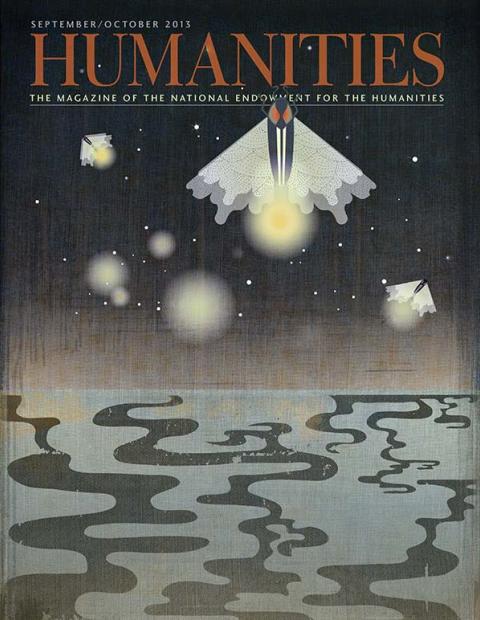Saddle up IQ readers, because we’re going to take a rollicking ride with Frank Christianson through the extraordinary life of William F. “Buffalo Bill” Cody. Christianson, an associate professor of English at Brigham Young University, is senior editor of the Papers of William F. Cody. The project, based at the Buffalo Bill Center of the West, has received two NEH grants to produce print and digital versions of Cody’s papers. Christianson served as editor of The Life of Hon. William F. Cody and The Wild West in England, both from University of Nebraska Press.
Cody went to work at age eleven after his father died. What was his first job?
Establishing a theme that would inform most of his working life, Cody’s first job was on horseback: He herded cattle in Kansas for a provisions supplier to the U.S. Army.
What other occupations did he claim?
In his autobiography, Cody recounts experiences as a teenage fur trapper and Pony Express rider that were likely fabricated. His actual employment included hunter, military scout and guide, magistrate, and entrepreneur. As a businessman, he tried town founding, newspaper publishing, land and mining speculation, and, of course, show business. His life was a cycle of booms and busts.
How did he get the nickname “Buffalo Bill”?
For eighteen months in 1867 and 1868, Cody worked as a professional buffalo hunter. He was employed by a supplier to the Kansas-Pacific Railway to hunt meat for the railroad workers. He claims to have killed 4,280 buffalo in that span. During this time, he participated in a buffalo-hunting contest, which may (or may not) have granted him the rights to the name Buffalo Bill.
What was Cody’s attitude toward Native Americans?
Complicated, inconsistent, evolving. From his earliest years, his relationship to Native Americans defined him. As a military scout, he had many violent encounters with Plains Indians and that experience became the basis for his stage persona. The myth of Buffalo Bill was built upon real and pretended adversity with Indians, but he would not have achieved his lasting success without the professional cooperation of Native Americans, such as Sitting Bull. Cody seemed to recognize these contradictions. Even as he dramatized the decline of native civilization as part of the story of Anglo-Saxon triumphalism, he spoke out for Native American rights and equal treatment under the law.
How did a frontiersman become an actor?
The novelist and playwright Ned Buntline convinced him to go to Chicago in 1872 and perform as himself in a Western melodrama. Although reluctant at first, Cody embraced the new opportunity and later that same year formed his own touring troupe, The Buffalo Bill Combination.
Was he any good?
If reviews of his stage plays are any indication, not in the conventional sense. Cody himself admitted that he couldn’t memorize lines or respond to cues, let alone play a part. But he was a gifted raconteur with immense personal charm, and his performance translated well in the less intimate space of the showground.
Dime novels also helped make Cody famous. What’s a typical plot?
Buffalo Bill as a stock hero encountering stock villains—Indians, outlaws, or Mormons—who threaten the weak and vulnerable and give Buffalo Bill the chance to ride to the rescue.
Basic elements of a Buffalo Bill’s Wild West show?
A two- to three-hour assault on the senses. The “exhibition”—as Cody insisted it be called—was marketed as what we might now term “edutainment.” It claimed to represent life on the frontier in the most realistic terms. The show featured real Native Americans (primarily Lakota Sioux), real cowboys, and livestock, including a herd of bison. A typical performance offered races between cowboys, Indians, and vaqueros, and feats of marksmanship—most famously by Annie Oakley. They demonstrated horsemanship skills, such as roping and bronco busting, and staged famous battles, such as “Custer’s Last Stand.”
Cody has been called a showbiz pioneer. What made him innovative?
From a logistical standpoint, Buffalo Bill’s Wild West was a modern marvel with hundreds of cast and crew, a menagerie of animals, and elaborate reproductions of western landscapes, including man-made mountains. The show helped inaugurate an entire industry of open-air spectacles. The Buffalo Bill brand was also a mass-marketing juggernaut on both sides of the Atlantic.
In 1887, Cody took his show to England. How did it do?
This was one instance when the actual success almost matched the hype. The Wild West built a twenty-thousand-seat arena and encampment in Earls Court. During its six-month London run, more than two million people saw the show. Cody was toasted by political and cultural elites, including Henry Irving, Bram Stoker, and Oscar Wilde. He hosted William Gladstone, the Prince and Princess of Wales, and gave a command performance for Queen Victoria on the eve of her Golden Jubilee.
Favorite Buffalo Bill story?
It’s more revealing than a favorite. In the wake of Custer’s death at Little Bighorn, Cody immediately left his touring company to rejoin his old Army regiment. On July 17, 1876, Cody fought in a skirmish near Warbonnet Creek in eastern Wyoming, killing a Cheyenne named Yellow Hair. Instead of a uniform, he wore his stage attire—a black-and-red velvet vaquero costume. Within a few months Cody was performing a newly commissioned play, The Red Right Hand, or First Scalp for Custer, wearing the same costume and brandishing the scalp and weapons of his fallen foe.


